Finance Report: Time Value of Money, Capital Budgeting Analysis
VerifiedAdded on 2023/01/18
|14
|2868
|25
Report
AI Summary
This finance report comprehensively analyzes key financial concepts, including the time value of money, capital budgeting, and financial investments. It explores the application of these concepts through the valuation of stocks using the dividend discount model and bonds, and the determination of yield to maturity. The report also delves into capital budgeting techniques like Net Present Value (NPV) and Internal Rate of Return (IRR) to assess project viability. Additionally, it examines the Weighted Average Cost of Capital (WACC) and its significance in financial decision-making, along with an analysis of investment options, considering both expected returns and associated risks. The report provides detailed calculations and interpretations, drawing from literature reviews and case studies to illustrate practical applications within financial markets.

Running head: FINANCE
Finance
Name of the Student:
Name of the University:
Author’s Note:
Finance
Name of the Student:
Name of the University:
Author’s Note:
Paraphrase This Document
Need a fresh take? Get an instant paraphrase of this document with our AI Paraphraser
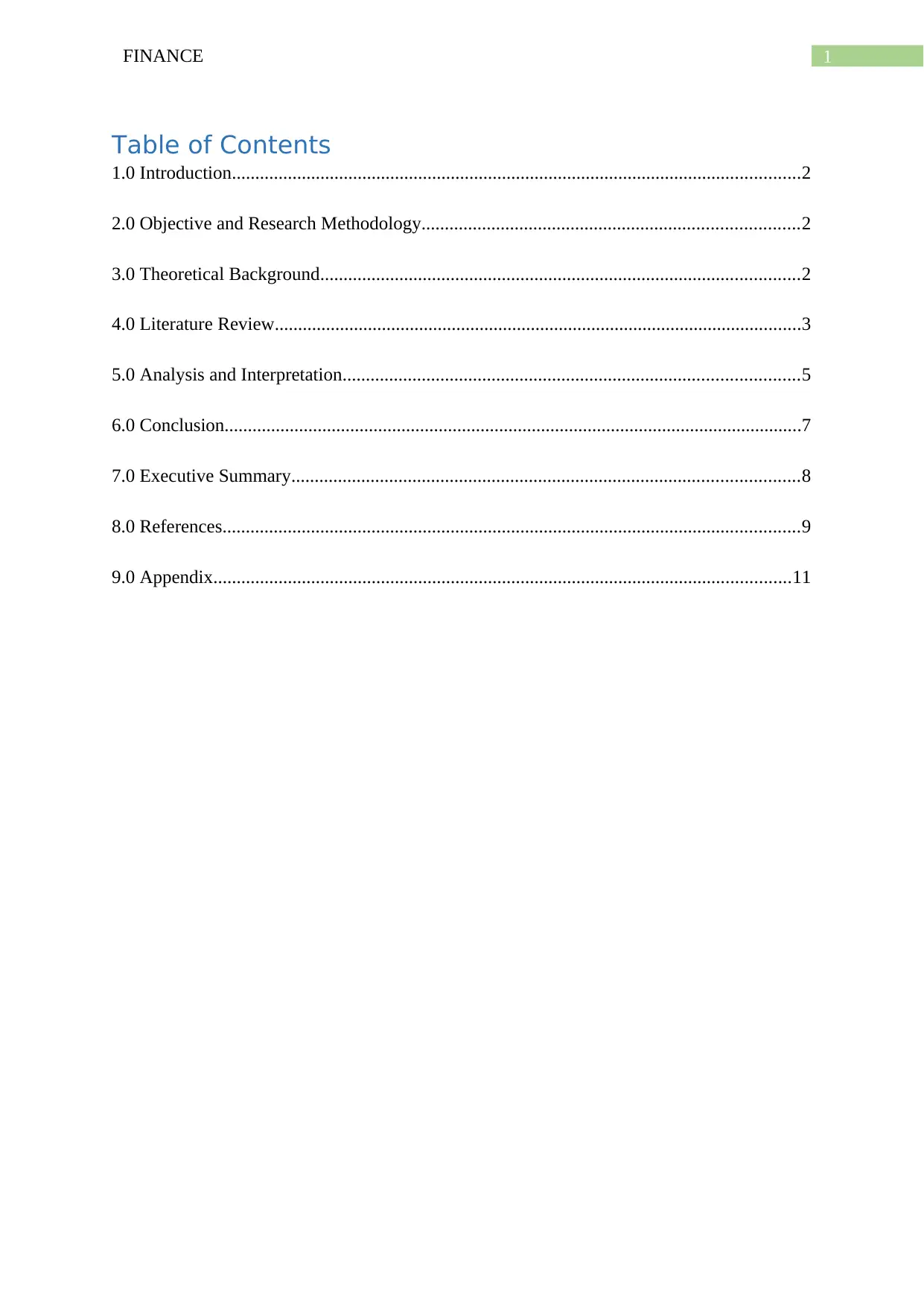
1FINANCE
Table of Contents
1.0 Introduction..........................................................................................................................2
2.0 Objective and Research Methodology.................................................................................2
3.0 Theoretical Background.......................................................................................................2
4.0 Literature Review.................................................................................................................3
5.0 Analysis and Interpretation..................................................................................................5
6.0 Conclusion............................................................................................................................7
7.0 Executive Summary.............................................................................................................8
8.0 References............................................................................................................................9
9.0 Appendix............................................................................................................................11
Table of Contents
1.0 Introduction..........................................................................................................................2
2.0 Objective and Research Methodology.................................................................................2
3.0 Theoretical Background.......................................................................................................2
4.0 Literature Review.................................................................................................................3
5.0 Analysis and Interpretation..................................................................................................5
6.0 Conclusion............................................................................................................................7
7.0 Executive Summary.............................................................................................................8
8.0 References............................................................................................................................9
9.0 Appendix............................................................................................................................11
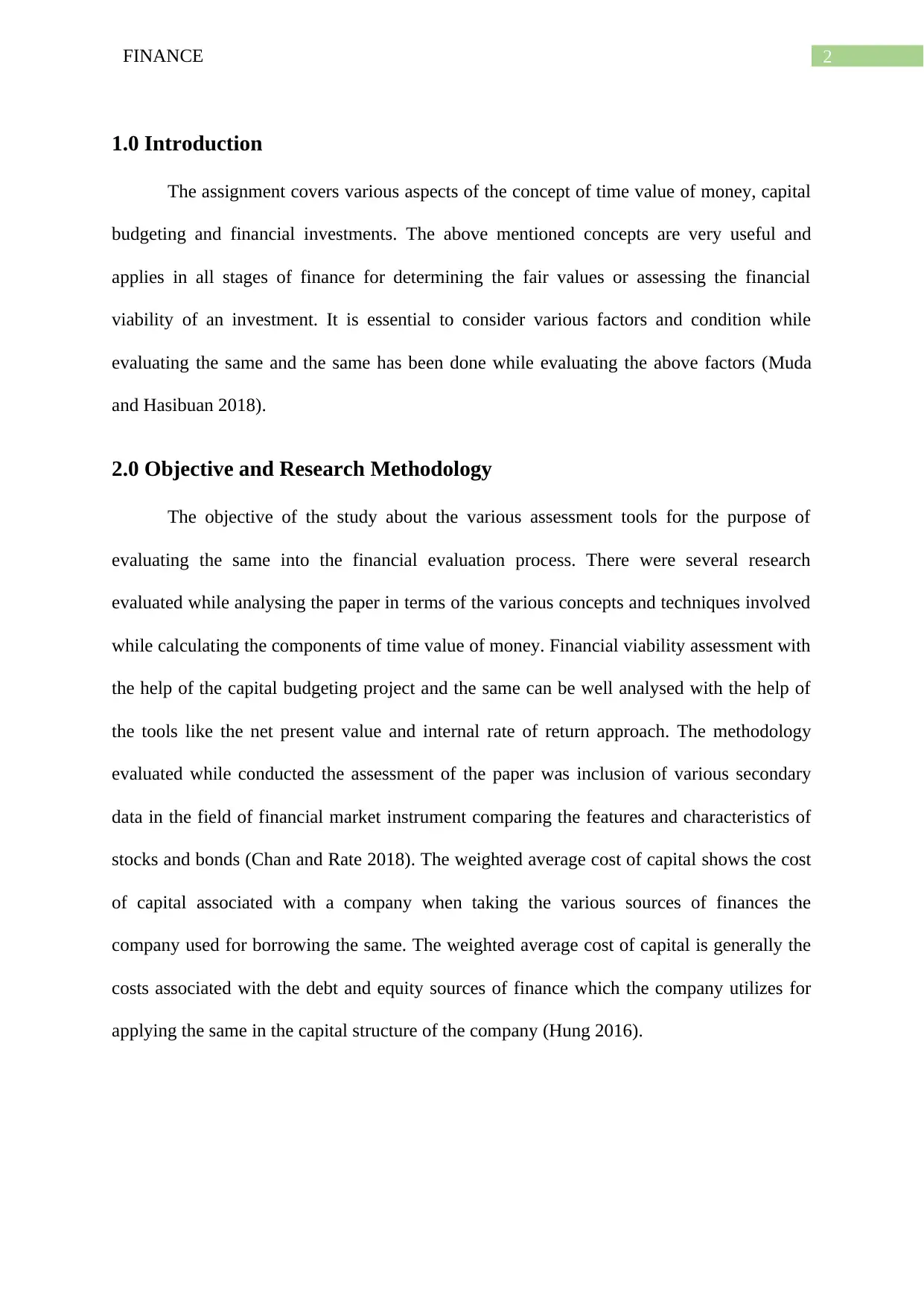
2FINANCE
1.0 Introduction
The assignment covers various aspects of the concept of time value of money, capital
budgeting and financial investments. The above mentioned concepts are very useful and
applies in all stages of finance for determining the fair values or assessing the financial
viability of an investment. It is essential to consider various factors and condition while
evaluating the same and the same has been done while evaluating the above factors (Muda
and Hasibuan 2018).
2.0 Objective and Research Methodology
The objective of the study about the various assessment tools for the purpose of
evaluating the same into the financial evaluation process. There were several research
evaluated while analysing the paper in terms of the various concepts and techniques involved
while calculating the components of time value of money. Financial viability assessment with
the help of the capital budgeting project and the same can be well analysed with the help of
the tools like the net present value and internal rate of return approach. The methodology
evaluated while conducted the assessment of the paper was inclusion of various secondary
data in the field of financial market instrument comparing the features and characteristics of
stocks and bonds (Chan and Rate 2018). The weighted average cost of capital shows the cost
of capital associated with a company when taking the various sources of finances the
company used for borrowing the same. The weighted average cost of capital is generally the
costs associated with the debt and equity sources of finance which the company utilizes for
applying the same in the capital structure of the company (Hung 2016).
1.0 Introduction
The assignment covers various aspects of the concept of time value of money, capital
budgeting and financial investments. The above mentioned concepts are very useful and
applies in all stages of finance for determining the fair values or assessing the financial
viability of an investment. It is essential to consider various factors and condition while
evaluating the same and the same has been done while evaluating the above factors (Muda
and Hasibuan 2018).
2.0 Objective and Research Methodology
The objective of the study about the various assessment tools for the purpose of
evaluating the same into the financial evaluation process. There were several research
evaluated while analysing the paper in terms of the various concepts and techniques involved
while calculating the components of time value of money. Financial viability assessment with
the help of the capital budgeting project and the same can be well analysed with the help of
the tools like the net present value and internal rate of return approach. The methodology
evaluated while conducted the assessment of the paper was inclusion of various secondary
data in the field of financial market instrument comparing the features and characteristics of
stocks and bonds (Chan and Rate 2018). The weighted average cost of capital shows the cost
of capital associated with a company when taking the various sources of finances the
company used for borrowing the same. The weighted average cost of capital is generally the
costs associated with the debt and equity sources of finance which the company utilizes for
applying the same in the capital structure of the company (Hung 2016).
⊘ This is a preview!⊘
Do you want full access?
Subscribe today to unlock all pages.

Trusted by 1+ million students worldwide
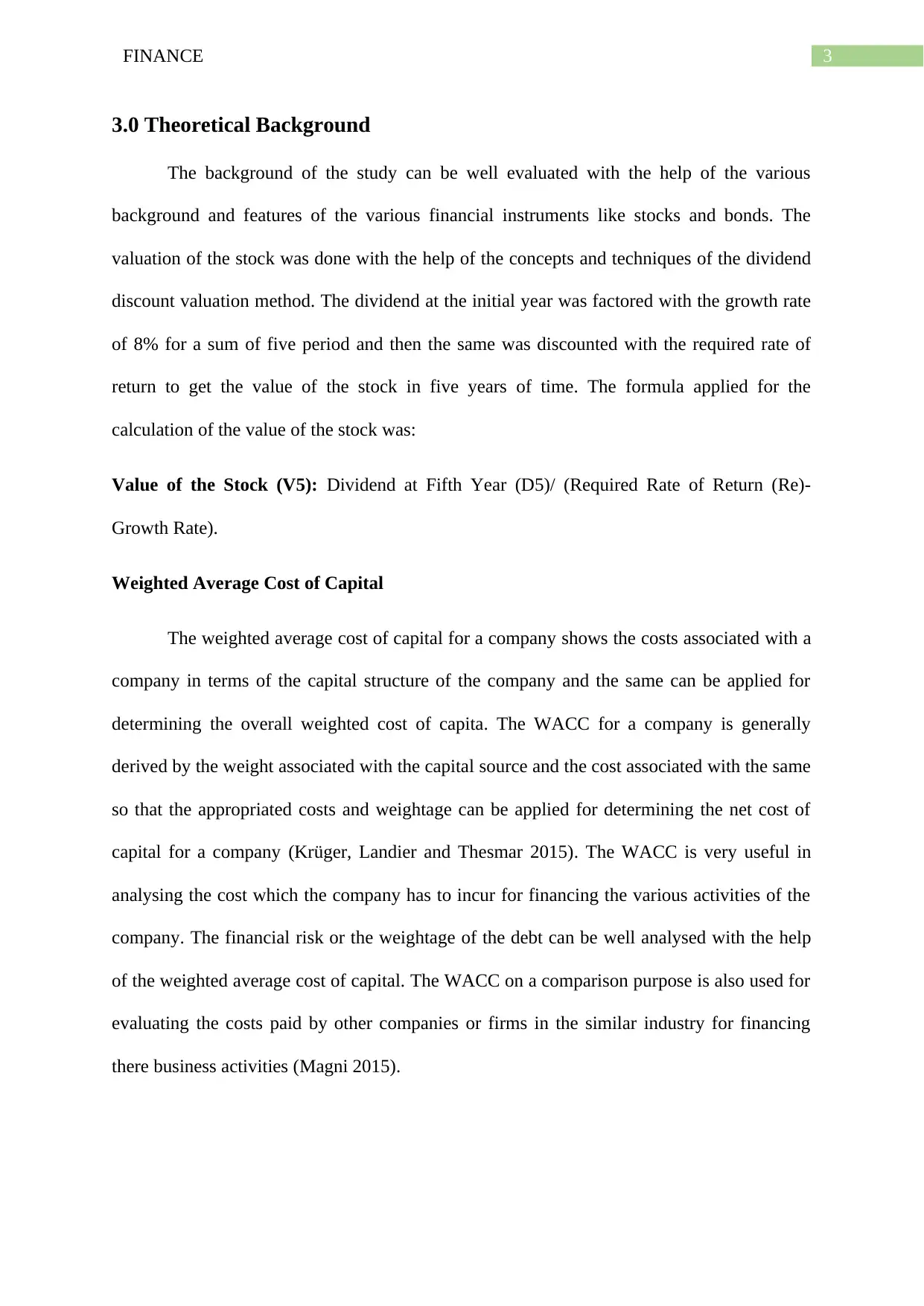
3FINANCE
3.0 Theoretical Background
The background of the study can be well evaluated with the help of the various
background and features of the various financial instruments like stocks and bonds. The
valuation of the stock was done with the help of the concepts and techniques of the dividend
discount valuation method. The dividend at the initial year was factored with the growth rate
of 8% for a sum of five period and then the same was discounted with the required rate of
return to get the value of the stock in five years of time. The formula applied for the
calculation of the value of the stock was:
Value of the Stock (V5): Dividend at Fifth Year (D5)/ (Required Rate of Return (Re)-
Growth Rate).
Weighted Average Cost of Capital
The weighted average cost of capital for a company shows the costs associated with a
company in terms of the capital structure of the company and the same can be applied for
determining the overall weighted cost of capita. The WACC for a company is generally
derived by the weight associated with the capital source and the cost associated with the same
so that the appropriated costs and weightage can be applied for determining the net cost of
capital for a company (Krüger, Landier and Thesmar 2015). The WACC is very useful in
analysing the cost which the company has to incur for financing the various activities of the
company. The financial risk or the weightage of the debt can be well analysed with the help
of the weighted average cost of capital. The WACC on a comparison purpose is also used for
evaluating the costs paid by other companies or firms in the similar industry for financing
there business activities (Magni 2015).
3.0 Theoretical Background
The background of the study can be well evaluated with the help of the various
background and features of the various financial instruments like stocks and bonds. The
valuation of the stock was done with the help of the concepts and techniques of the dividend
discount valuation method. The dividend at the initial year was factored with the growth rate
of 8% for a sum of five period and then the same was discounted with the required rate of
return to get the value of the stock in five years of time. The formula applied for the
calculation of the value of the stock was:
Value of the Stock (V5): Dividend at Fifth Year (D5)/ (Required Rate of Return (Re)-
Growth Rate).
Weighted Average Cost of Capital
The weighted average cost of capital for a company shows the costs associated with a
company in terms of the capital structure of the company and the same can be applied for
determining the overall weighted cost of capita. The WACC for a company is generally
derived by the weight associated with the capital source and the cost associated with the same
so that the appropriated costs and weightage can be applied for determining the net cost of
capital for a company (Krüger, Landier and Thesmar 2015). The WACC is very useful in
analysing the cost which the company has to incur for financing the various activities of the
company. The financial risk or the weightage of the debt can be well analysed with the help
of the weighted average cost of capital. The WACC on a comparison purpose is also used for
evaluating the costs paid by other companies or firms in the similar industry for financing
there business activities (Magni 2015).
Paraphrase This Document
Need a fresh take? Get an instant paraphrase of this document with our AI Paraphraser
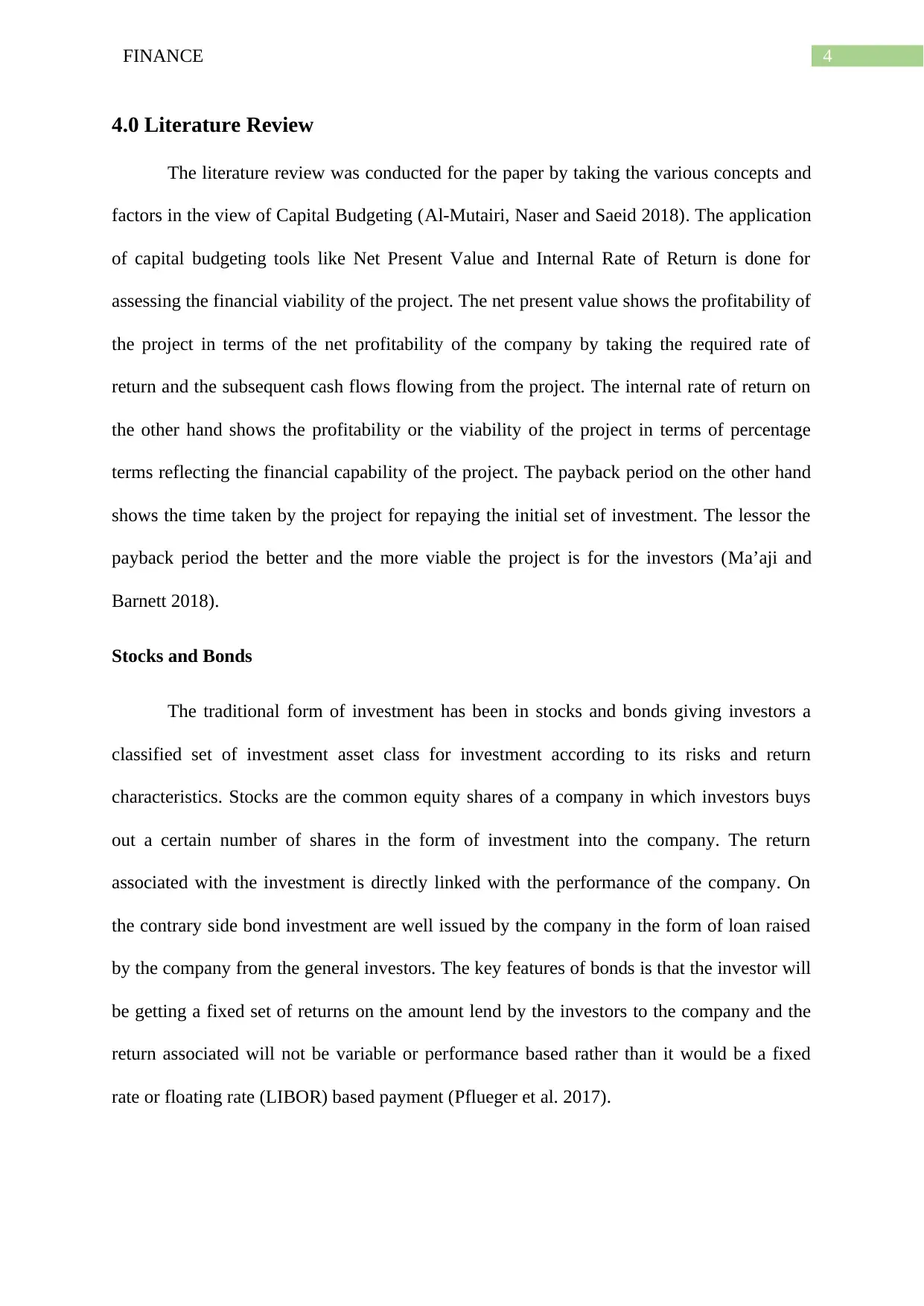
4FINANCE
4.0 Literature Review
The literature review was conducted for the paper by taking the various concepts and
factors in the view of Capital Budgeting (Al-Mutairi, Naser and Saeid 2018). The application
of capital budgeting tools like Net Present Value and Internal Rate of Return is done for
assessing the financial viability of the project. The net present value shows the profitability of
the project in terms of the net profitability of the company by taking the required rate of
return and the subsequent cash flows flowing from the project. The internal rate of return on
the other hand shows the profitability or the viability of the project in terms of percentage
terms reflecting the financial capability of the project. The payback period on the other hand
shows the time taken by the project for repaying the initial set of investment. The lessor the
payback period the better and the more viable the project is for the investors (Ma’aji and
Barnett 2018).
Stocks and Bonds
The traditional form of investment has been in stocks and bonds giving investors a
classified set of investment asset class for investment according to its risks and return
characteristics. Stocks are the common equity shares of a company in which investors buys
out a certain number of shares in the form of investment into the company. The return
associated with the investment is directly linked with the performance of the company. On
the contrary side bond investment are well issued by the company in the form of loan raised
by the company from the general investors. The key features of bonds is that the investor will
be getting a fixed set of returns on the amount lend by the investors to the company and the
return associated will not be variable or performance based rather than it would be a fixed
rate or floating rate (LIBOR) based payment (Pflueger et al. 2017).
4.0 Literature Review
The literature review was conducted for the paper by taking the various concepts and
factors in the view of Capital Budgeting (Al-Mutairi, Naser and Saeid 2018). The application
of capital budgeting tools like Net Present Value and Internal Rate of Return is done for
assessing the financial viability of the project. The net present value shows the profitability of
the project in terms of the net profitability of the company by taking the required rate of
return and the subsequent cash flows flowing from the project. The internal rate of return on
the other hand shows the profitability or the viability of the project in terms of percentage
terms reflecting the financial capability of the project. The payback period on the other hand
shows the time taken by the project for repaying the initial set of investment. The lessor the
payback period the better and the more viable the project is for the investors (Ma’aji and
Barnett 2018).
Stocks and Bonds
The traditional form of investment has been in stocks and bonds giving investors a
classified set of investment asset class for investment according to its risks and return
characteristics. Stocks are the common equity shares of a company in which investors buys
out a certain number of shares in the form of investment into the company. The return
associated with the investment is directly linked with the performance of the company. On
the contrary side bond investment are well issued by the company in the form of loan raised
by the company from the general investors. The key features of bonds is that the investor will
be getting a fixed set of returns on the amount lend by the investors to the company and the
return associated will not be variable or performance based rather than it would be a fixed
rate or floating rate (LIBOR) based payment (Pflueger et al. 2017).
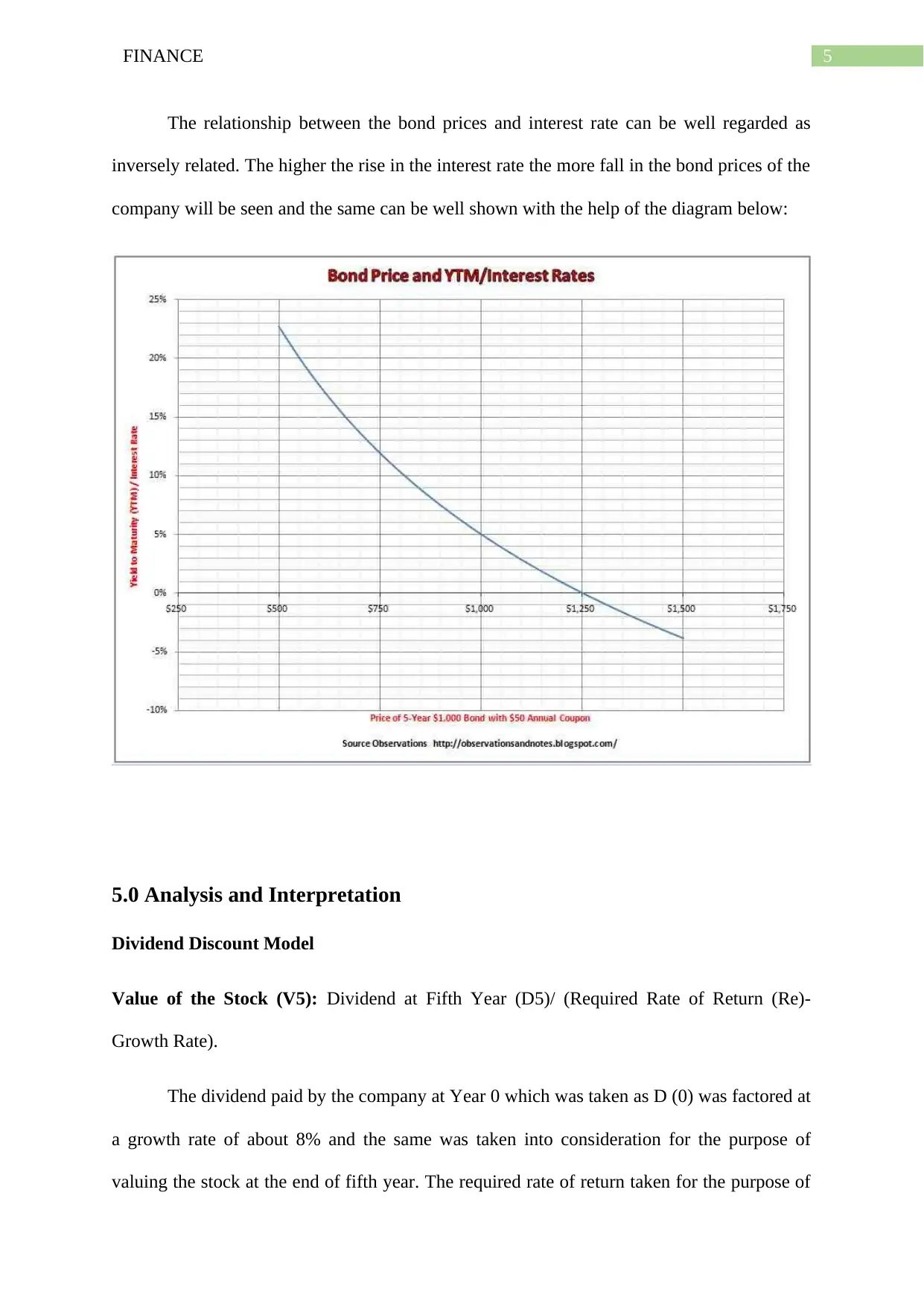
5FINANCE
The relationship between the bond prices and interest rate can be well regarded as
inversely related. The higher the rise in the interest rate the more fall in the bond prices of the
company will be seen and the same can be well shown with the help of the diagram below:
5.0 Analysis and Interpretation
Dividend Discount Model
Value of the Stock (V5): Dividend at Fifth Year (D5)/ (Required Rate of Return (Re)-
Growth Rate).
The dividend paid by the company at Year 0 which was taken as D (0) was factored at
a growth rate of about 8% and the same was taken into consideration for the purpose of
valuing the stock at the end of fifth year. The required rate of return taken for the purpose of
The relationship between the bond prices and interest rate can be well regarded as
inversely related. The higher the rise in the interest rate the more fall in the bond prices of the
company will be seen and the same can be well shown with the help of the diagram below:
5.0 Analysis and Interpretation
Dividend Discount Model
Value of the Stock (V5): Dividend at Fifth Year (D5)/ (Required Rate of Return (Re)-
Growth Rate).
The dividend paid by the company at Year 0 which was taken as D (0) was factored at
a growth rate of about 8% and the same was taken into consideration for the purpose of
valuing the stock at the end of fifth year. The required rate of return taken for the purpose of
⊘ This is a preview!⊘
Do you want full access?
Subscribe today to unlock all pages.

Trusted by 1+ million students worldwide
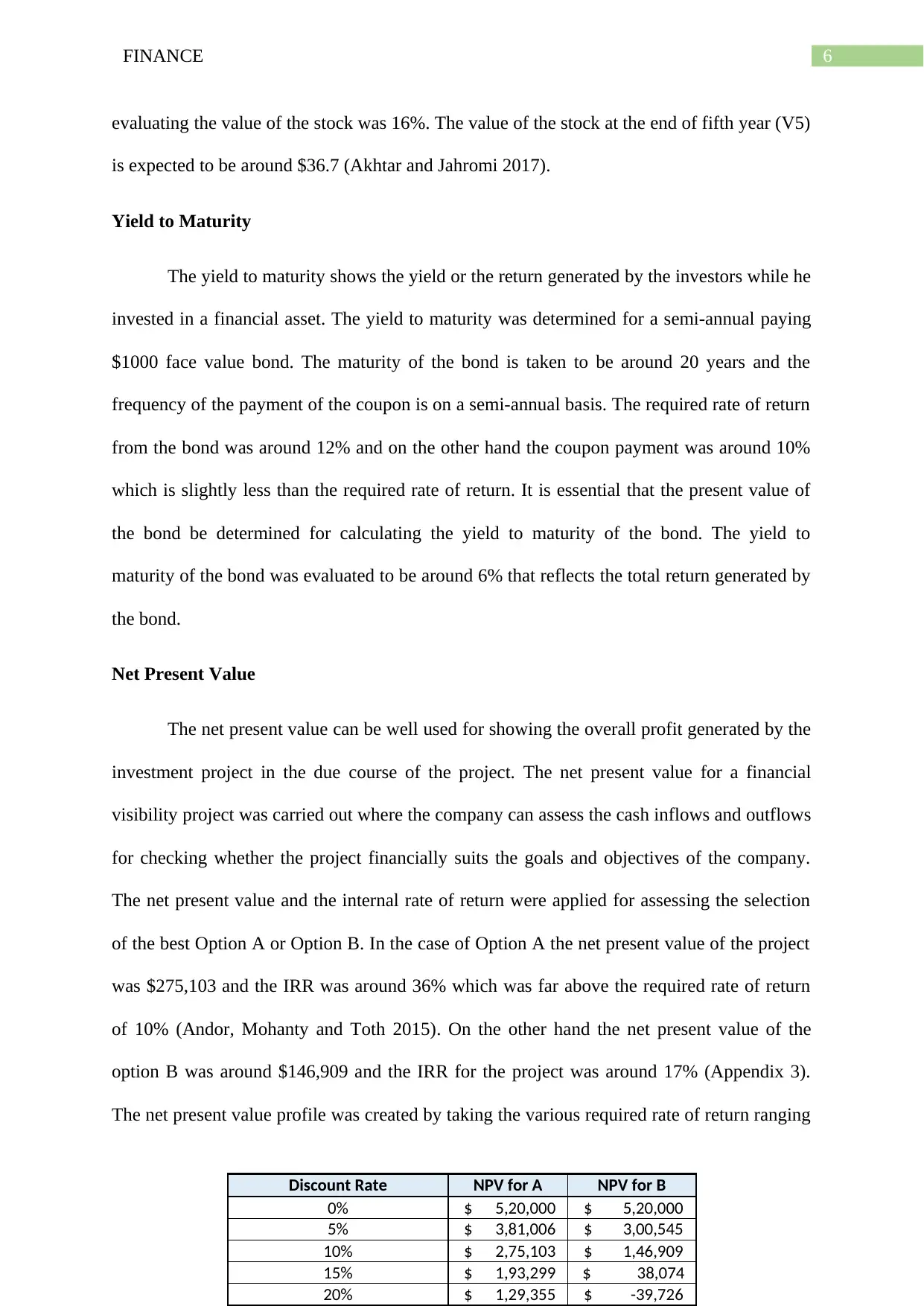
6FINANCE
evaluating the value of the stock was 16%. The value of the stock at the end of fifth year (V5)
is expected to be around $36.7 (Akhtar and Jahromi 2017).
Yield to Maturity
The yield to maturity shows the yield or the return generated by the investors while he
invested in a financial asset. The yield to maturity was determined for a semi-annual paying
$1000 face value bond. The maturity of the bond is taken to be around 20 years and the
frequency of the payment of the coupon is on a semi-annual basis. The required rate of return
from the bond was around 12% and on the other hand the coupon payment was around 10%
which is slightly less than the required rate of return. It is essential that the present value of
the bond be determined for calculating the yield to maturity of the bond. The yield to
maturity of the bond was evaluated to be around 6% that reflects the total return generated by
the bond.
Net Present Value
The net present value can be well used for showing the overall profit generated by the
investment project in the due course of the project. The net present value for a financial
visibility project was carried out where the company can assess the cash inflows and outflows
for checking whether the project financially suits the goals and objectives of the company.
The net present value and the internal rate of return were applied for assessing the selection
of the best Option A or Option B. In the case of Option A the net present value of the project
was $275,103 and the IRR was around 36% which was far above the required rate of return
of 10% (Andor, Mohanty and Toth 2015). On the other hand the net present value of the
option B was around $146,909 and the IRR for the project was around 17% (Appendix 3).
The net present value profile was created by taking the various required rate of return ranging
Discount Rate NPV for A NPV for B
0% $ 5,20,000 $ 5,20,000
5% $ 3,81,006 $ 3,00,545
10% $ 2,75,103 $ 1,46,909
15% $ 1,93,299 $ 38,074
20% $ 1,29,355 $ -39,726
evaluating the value of the stock was 16%. The value of the stock at the end of fifth year (V5)
is expected to be around $36.7 (Akhtar and Jahromi 2017).
Yield to Maturity
The yield to maturity shows the yield or the return generated by the investors while he
invested in a financial asset. The yield to maturity was determined for a semi-annual paying
$1000 face value bond. The maturity of the bond is taken to be around 20 years and the
frequency of the payment of the coupon is on a semi-annual basis. The required rate of return
from the bond was around 12% and on the other hand the coupon payment was around 10%
which is slightly less than the required rate of return. It is essential that the present value of
the bond be determined for calculating the yield to maturity of the bond. The yield to
maturity of the bond was evaluated to be around 6% that reflects the total return generated by
the bond.
Net Present Value
The net present value can be well used for showing the overall profit generated by the
investment project in the due course of the project. The net present value for a financial
visibility project was carried out where the company can assess the cash inflows and outflows
for checking whether the project financially suits the goals and objectives of the company.
The net present value and the internal rate of return were applied for assessing the selection
of the best Option A or Option B. In the case of Option A the net present value of the project
was $275,103 and the IRR was around 36% which was far above the required rate of return
of 10% (Andor, Mohanty and Toth 2015). On the other hand the net present value of the
option B was around $146,909 and the IRR for the project was around 17% (Appendix 3).
The net present value profile was created by taking the various required rate of return ranging
Discount Rate NPV for A NPV for B
0% $ 5,20,000 $ 5,20,000
5% $ 3,81,006 $ 3,00,545
10% $ 2,75,103 $ 1,46,909
15% $ 1,93,299 $ 38,074
20% $ 1,29,355 $ -39,726
Paraphrase This Document
Need a fresh take? Get an instant paraphrase of this document with our AI Paraphraser
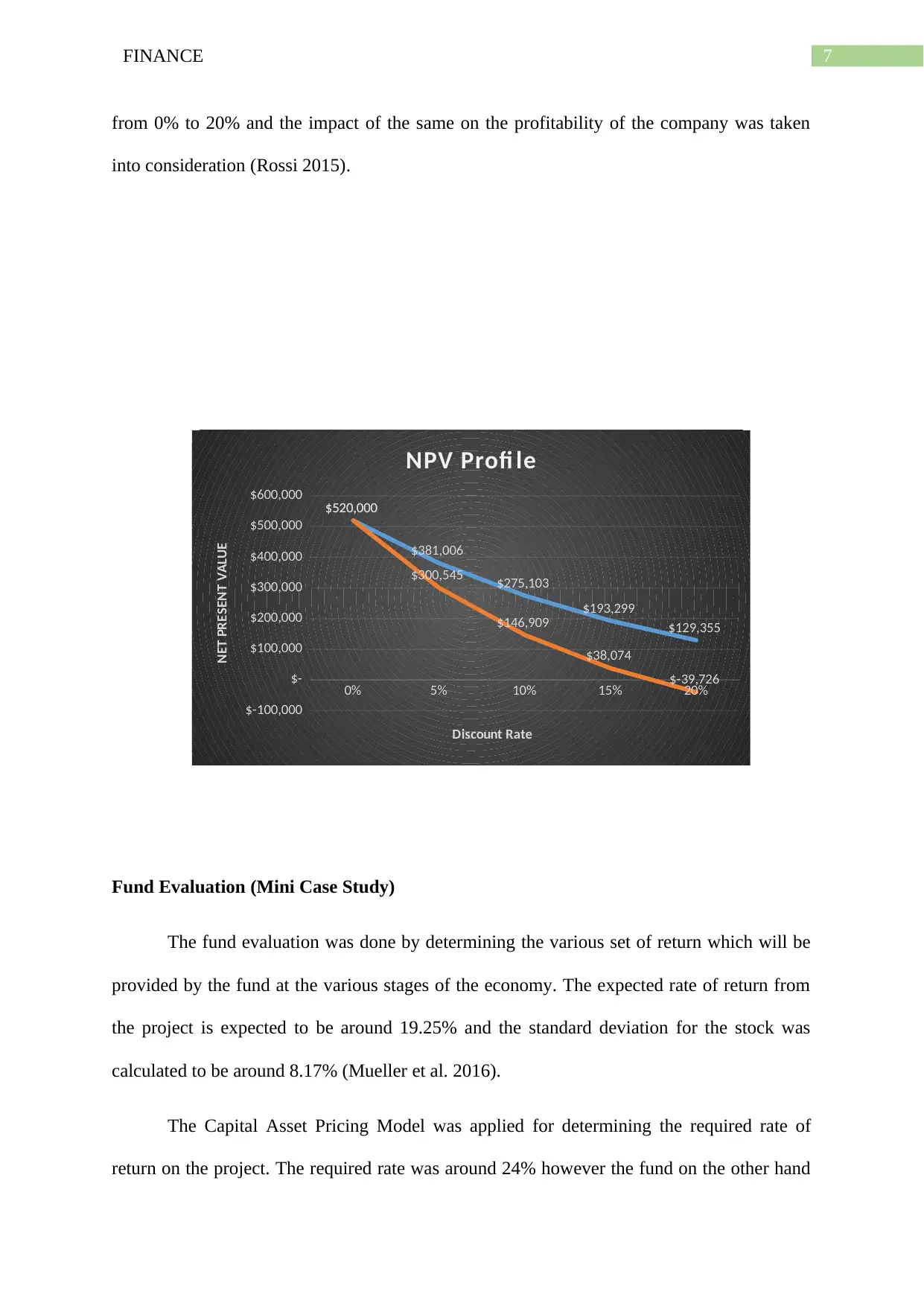
7FINANCE
from 0% to 20% and the impact of the same on the profitability of the company was taken
into consideration (Rossi 2015).
Fund Evaluation (Mini Case Study)
The fund evaluation was done by determining the various set of return which will be
provided by the fund at the various stages of the economy. The expected rate of return from
the project is expected to be around 19.25% and the standard deviation for the stock was
calculated to be around 8.17% (Mueller et al. 2016).
The Capital Asset Pricing Model was applied for determining the required rate of
return on the project. The required rate was around 24% however the fund on the other hand
0% 5% 10% 15% 20%
$-100,000
$-
$100,000
$200,000
$300,000
$400,000
$500,000
$600,000 $520,000
$381,006
$275,103
$193,299
$129,355
$520,000
$300,545
$146,909
$38,074
$-39,726
NPV Profi le
Discount Rate
NET PRESENT VALUE
from 0% to 20% and the impact of the same on the profitability of the company was taken
into consideration (Rossi 2015).
Fund Evaluation (Mini Case Study)
The fund evaluation was done by determining the various set of return which will be
provided by the fund at the various stages of the economy. The expected rate of return from
the project is expected to be around 19.25% and the standard deviation for the stock was
calculated to be around 8.17% (Mueller et al. 2016).
The Capital Asset Pricing Model was applied for determining the required rate of
return on the project. The required rate was around 24% however the fund on the other hand
0% 5% 10% 15% 20%
$-100,000
$-
$100,000
$200,000
$300,000
$400,000
$500,000
$600,000 $520,000
$381,006
$275,103
$193,299
$129,355
$520,000
$300,545
$146,909
$38,074
$-39,726
NPV Profi le
Discount Rate
NET PRESENT VALUE
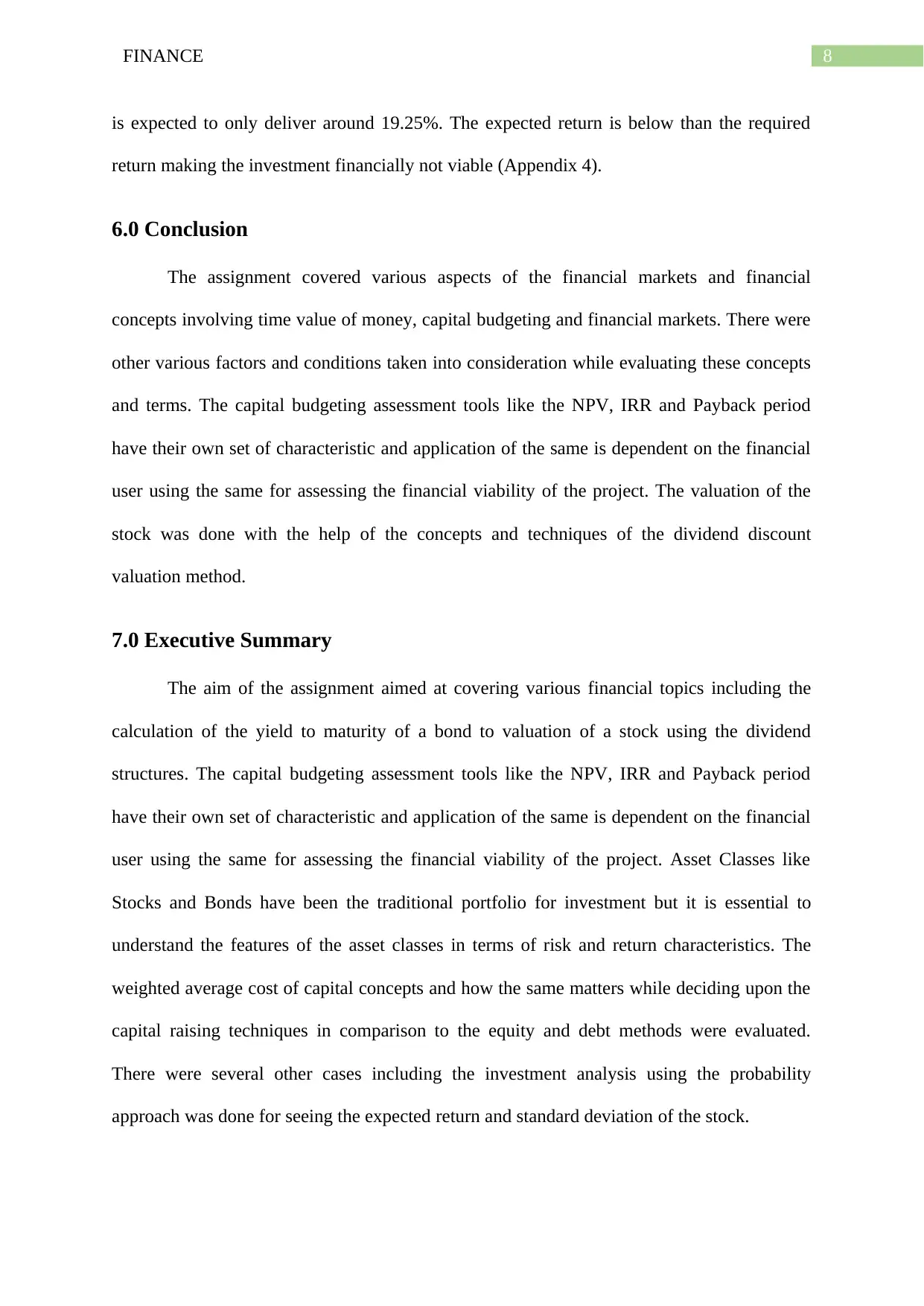
8FINANCE
is expected to only deliver around 19.25%. The expected return is below than the required
return making the investment financially not viable (Appendix 4).
6.0 Conclusion
The assignment covered various aspects of the financial markets and financial
concepts involving time value of money, capital budgeting and financial markets. There were
other various factors and conditions taken into consideration while evaluating these concepts
and terms. The capital budgeting assessment tools like the NPV, IRR and Payback period
have their own set of characteristic and application of the same is dependent on the financial
user using the same for assessing the financial viability of the project. The valuation of the
stock was done with the help of the concepts and techniques of the dividend discount
valuation method.
7.0 Executive Summary
The aim of the assignment aimed at covering various financial topics including the
calculation of the yield to maturity of a bond to valuation of a stock using the dividend
structures. The capital budgeting assessment tools like the NPV, IRR and Payback period
have their own set of characteristic and application of the same is dependent on the financial
user using the same for assessing the financial viability of the project. Asset Classes like
Stocks and Bonds have been the traditional portfolio for investment but it is essential to
understand the features of the asset classes in terms of risk and return characteristics. The
weighted average cost of capital concepts and how the same matters while deciding upon the
capital raising techniques in comparison to the equity and debt methods were evaluated.
There were several other cases including the investment analysis using the probability
approach was done for seeing the expected return and standard deviation of the stock.
is expected to only deliver around 19.25%. The expected return is below than the required
return making the investment financially not viable (Appendix 4).
6.0 Conclusion
The assignment covered various aspects of the financial markets and financial
concepts involving time value of money, capital budgeting and financial markets. There were
other various factors and conditions taken into consideration while evaluating these concepts
and terms. The capital budgeting assessment tools like the NPV, IRR and Payback period
have their own set of characteristic and application of the same is dependent on the financial
user using the same for assessing the financial viability of the project. The valuation of the
stock was done with the help of the concepts and techniques of the dividend discount
valuation method.
7.0 Executive Summary
The aim of the assignment aimed at covering various financial topics including the
calculation of the yield to maturity of a bond to valuation of a stock using the dividend
structures. The capital budgeting assessment tools like the NPV, IRR and Payback period
have their own set of characteristic and application of the same is dependent on the financial
user using the same for assessing the financial viability of the project. Asset Classes like
Stocks and Bonds have been the traditional portfolio for investment but it is essential to
understand the features of the asset classes in terms of risk and return characteristics. The
weighted average cost of capital concepts and how the same matters while deciding upon the
capital raising techniques in comparison to the equity and debt methods were evaluated.
There were several other cases including the investment analysis using the probability
approach was done for seeing the expected return and standard deviation of the stock.
⊘ This is a preview!⊘
Do you want full access?
Subscribe today to unlock all pages.

Trusted by 1+ million students worldwide
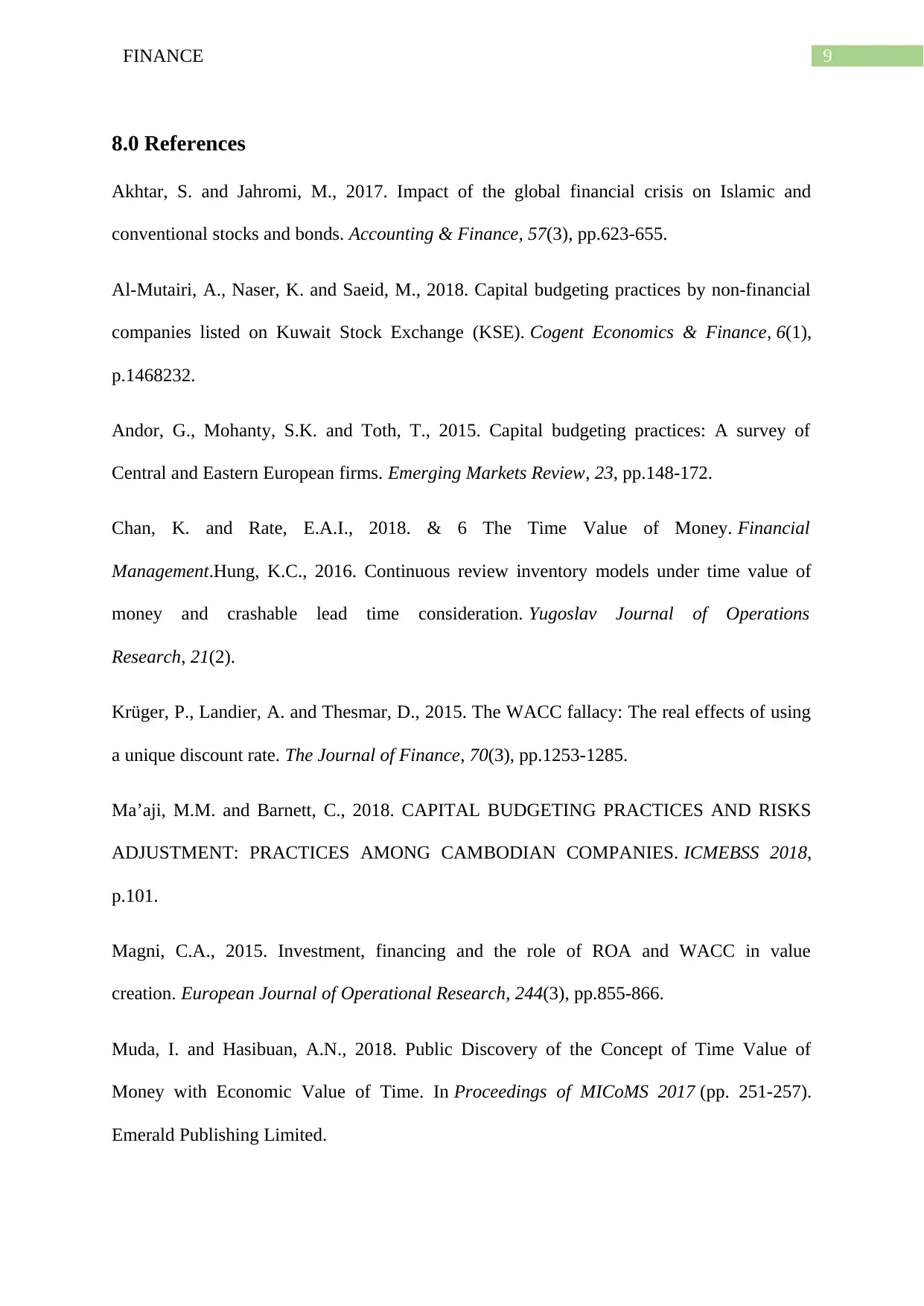
9FINANCE
8.0 References
Akhtar, S. and Jahromi, M., 2017. Impact of the global financial crisis on Islamic and
conventional stocks and bonds. Accounting & Finance, 57(3), pp.623-655.
Al-Mutairi, A., Naser, K. and Saeid, M., 2018. Capital budgeting practices by non-financial
companies listed on Kuwait Stock Exchange (KSE). Cogent Economics & Finance, 6(1),
p.1468232.
Andor, G., Mohanty, S.K. and Toth, T., 2015. Capital budgeting practices: A survey of
Central and Eastern European firms. Emerging Markets Review, 23, pp.148-172.
Chan, K. and Rate, E.A.I., 2018. & 6 The Time Value of Money. Financial
Management.Hung, K.C., 2016. Continuous review inventory models under time value of
money and crashable lead time consideration. Yugoslav Journal of Operations
Research, 21(2).
Krüger, P., Landier, A. and Thesmar, D., 2015. The WACC fallacy: The real effects of using
a unique discount rate. The Journal of Finance, 70(3), pp.1253-1285.
Ma’aji, M.M. and Barnett, C., 2018. CAPITAL BUDGETING PRACTICES AND RISKS
ADJUSTMENT: PRACTICES AMONG CAMBODIAN COMPANIES. ICMEBSS 2018,
p.101.
Magni, C.A., 2015. Investment, financing and the role of ROA and WACC in value
creation. European Journal of Operational Research, 244(3), pp.855-866.
Muda, I. and Hasibuan, A.N., 2018. Public Discovery of the Concept of Time Value of
Money with Economic Value of Time. In Proceedings of MICoMS 2017 (pp. 251-257).
Emerald Publishing Limited.
8.0 References
Akhtar, S. and Jahromi, M., 2017. Impact of the global financial crisis on Islamic and
conventional stocks and bonds. Accounting & Finance, 57(3), pp.623-655.
Al-Mutairi, A., Naser, K. and Saeid, M., 2018. Capital budgeting practices by non-financial
companies listed on Kuwait Stock Exchange (KSE). Cogent Economics & Finance, 6(1),
p.1468232.
Andor, G., Mohanty, S.K. and Toth, T., 2015. Capital budgeting practices: A survey of
Central and Eastern European firms. Emerging Markets Review, 23, pp.148-172.
Chan, K. and Rate, E.A.I., 2018. & 6 The Time Value of Money. Financial
Management.Hung, K.C., 2016. Continuous review inventory models under time value of
money and crashable lead time consideration. Yugoslav Journal of Operations
Research, 21(2).
Krüger, P., Landier, A. and Thesmar, D., 2015. The WACC fallacy: The real effects of using
a unique discount rate. The Journal of Finance, 70(3), pp.1253-1285.
Ma’aji, M.M. and Barnett, C., 2018. CAPITAL BUDGETING PRACTICES AND RISKS
ADJUSTMENT: PRACTICES AMONG CAMBODIAN COMPANIES. ICMEBSS 2018,
p.101.
Magni, C.A., 2015. Investment, financing and the role of ROA and WACC in value
creation. European Journal of Operational Research, 244(3), pp.855-866.
Muda, I. and Hasibuan, A.N., 2018. Public Discovery of the Concept of Time Value of
Money with Economic Value of Time. In Proceedings of MICoMS 2017 (pp. 251-257).
Emerald Publishing Limited.
Paraphrase This Document
Need a fresh take? Get an instant paraphrase of this document with our AI Paraphraser

10FINANCE
Mueller, P., Sabtchevsky, P., Vedolin, A. and Whelan, P., 2016. Variance risk premia on
stocks and bonds. In The 43rd European Finance Association Annual Meeting (EFA 2016).
Pflueger, C., Siriwardane, E.N. and Sunderam, A.V., 2017. Precautionary Savings in Stocks
and Bonds.
Rossi, M., 2015. The use of capital budgeting techniques: an outlook from
Italy. International Journal of Management Practice, 8(1), pp.43-56.
Mueller, P., Sabtchevsky, P., Vedolin, A. and Whelan, P., 2016. Variance risk premia on
stocks and bonds. In The 43rd European Finance Association Annual Meeting (EFA 2016).
Pflueger, C., Siriwardane, E.N. and Sunderam, A.V., 2017. Precautionary Savings in Stocks
and Bonds.
Rossi, M., 2015. The use of capital budgeting techniques: an outlook from
Italy. International Journal of Management Practice, 8(1), pp.43-56.
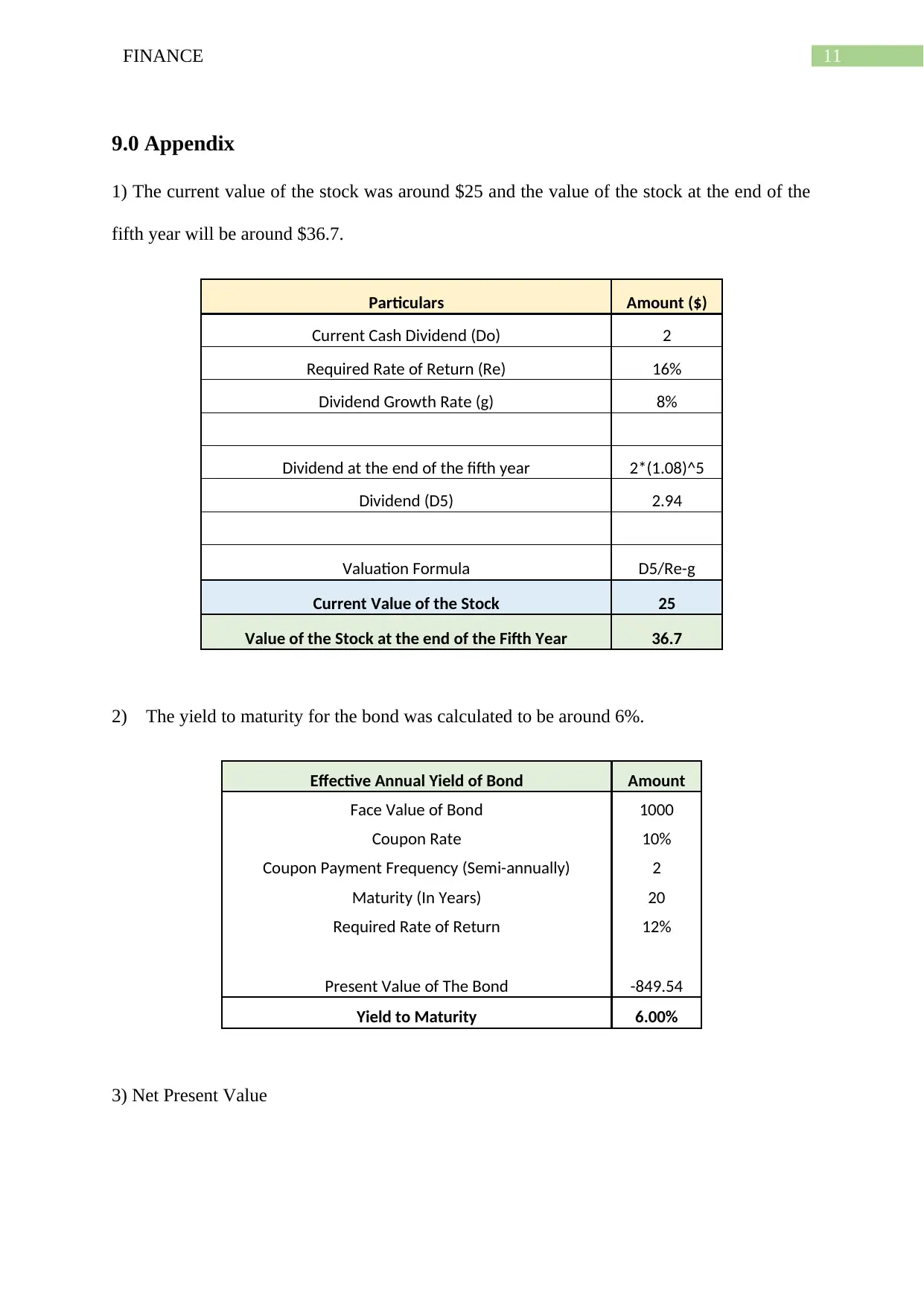
11FINANCE
9.0 Appendix
1) The current value of the stock was around $25 and the value of the stock at the end of the
fifth year will be around $36.7.
Particulars Amount ($)
Current Cash Dividend (Do) 2
Required Rate of Return (Re) 16%
Dividend Growth Rate (g) 8%
Dividend at the end of the fifth year 2*(1.08)^5
Dividend (D5) 2.94
Valuation Formula D5/Re-g
Current Value of the Stock 25
Value of the Stock at the end of the Fifth Year 36.7
2) The yield to maturity for the bond was calculated to be around 6%.
Effective Annual Yield of Bond Amount
Face Value of Bond 1000
Coupon Rate 10%
Coupon Payment Frequency (Semi-annually) 2
Maturity (In Years) 20
Required Rate of Return 12%
Present Value of The Bond -849.54
Yield to Maturity 6.00%
3) Net Present Value
9.0 Appendix
1) The current value of the stock was around $25 and the value of the stock at the end of the
fifth year will be around $36.7.
Particulars Amount ($)
Current Cash Dividend (Do) 2
Required Rate of Return (Re) 16%
Dividend Growth Rate (g) 8%
Dividend at the end of the fifth year 2*(1.08)^5
Dividend (D5) 2.94
Valuation Formula D5/Re-g
Current Value of the Stock 25
Value of the Stock at the end of the Fifth Year 36.7
2) The yield to maturity for the bond was calculated to be around 6%.
Effective Annual Yield of Bond Amount
Face Value of Bond 1000
Coupon Rate 10%
Coupon Payment Frequency (Semi-annually) 2
Maturity (In Years) 20
Required Rate of Return 12%
Present Value of The Bond -849.54
Yield to Maturity 6.00%
3) Net Present Value
⊘ This is a preview!⊘
Do you want full access?
Subscribe today to unlock all pages.

Trusted by 1+ million students worldwide
1 out of 14
Related Documents
Your All-in-One AI-Powered Toolkit for Academic Success.
+13062052269
info@desklib.com
Available 24*7 on WhatsApp / Email
![[object Object]](/_next/static/media/star-bottom.7253800d.svg)
Unlock your academic potential
Copyright © 2020–2025 A2Z Services. All Rights Reserved. Developed and managed by ZUCOL.





